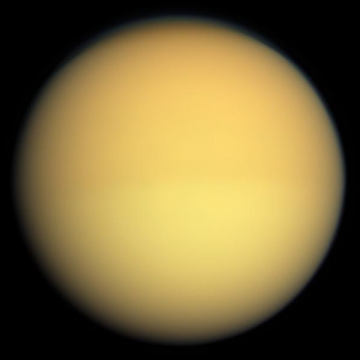
Saturn’s largest moon Titan is a fascinating world, uniquely alien yet eerily Earth-like in many ways, with its rain, rivers, lakes, seas, and massive sand dunes. But in this extremely cold environment, it is liquid methane and ethane which act as “water,” mimicking the hydrological cycle on Earth. Also, due to the perpetual and global hazy cloud cover, the only way to see these features from orbit is by using radar, which is what the Cassini spacecraft has done on a regular basis for quite a few years now. As good as they are, though, the radar images contain electronic noise, which reduces sharpness and clarity. But now a new technique is letting planetary scientists see Titan’s surface more clearly than ever before.

The technique is referred to as “despeckling” and produces cleaner images than the original radar images from the Cassini Synthetic Aperture Radar (SAR) instrument on Cassini. It uses an algorithm to modify the noise in the images, making it easier to see small-scale features or changes in the landscape. The idea was initiated by Antoine Lucas while he was working with members of the Cassini imaging team. He was a postdoctoral researcher at the California Institute of Technology in Pasadena at the time.
“Noise in the images gave me headaches,” said Lucas. Understandable, as it can make the images more difficult to interpret and, of course, just makes them less clear than they could be. But now, Lucas said, “My headaches were gone, and more importantly, we were able to go further in our understanding of Titan’s surface using the new technique.”
According to Randy Kirk, a Cassini radar team member from the U.S. Geologic Survey in Flagstaff, Ariz., “This is an amazing technique, and Antoine has done a great job of showing that we can trust it not to put features into the images that aren’t really there. It takes a lot of computation, and at the moment quite a bit of ‘fine-tuning’ to get the best results with each new image, so for now we’ll likely be despeckling only the most important – or most puzzling – images.”
It is thought that the speckle noise itself, when analyzed separately, might be useful, providing clues about the surface and even the subsurface of Titan.

Scientists can also now produce better 3-D digital elevation maps of Titan’s surface, as well as seeing sea and lake shorelines, river channels, and dunes in greater detail.

“This new technique provides a fresh look at the data, which helps us better understand the original images,” said Stephen Wall, deputy team lead of Cassini’s radar team, based at NASA’s Jet Propulsion Laboratory in Pasadena, Calif. “With this innovative new tool, we will look for details that help us to distinguish among the different processes that shape Titan’s surface,” he added.
While getting a better look at surface features in general, the technique could also help to solve some Titanian mysteries such as the “magic islands” in some of the seas which seem to appear and disappear at different times. Puzzling features like these only make Titan even more enticing to scientists. There is also thought to be a subsurface ocean of water, similar to moons like Europa and Enceladus. With an atmosphere rich in organic compounds, some scientists have even suggested that some form of primitive life might exist in the hydrocarbon seas and lakes, despite the bitter cold.
Titan is a complex world, with hydrological and geological processes that scientists are just beginning to explore and understand. Concepts for more advanced future landers, or even a boat or submarine to explore a Titanian sea, are being designed, even if still uncertain when they may ever launch. Exciting, but until then these enhanced images (and ones from the Huygens lander in 2005) will help to better show Titan as the incredible world that it really is.
Information about the new technique was published recently in the Journal of Geophysical Research: Planets.
More information about Cassini and Titan is available here.
Want to keep up-to-date with all things space? Be sure to “Like” AmericaSpace on Facebook and follow us on Twitter: @AmericaSpace




One Comment
One Ping
Pingback:New technique provides better, clearer radar images of Titan's amazing surface